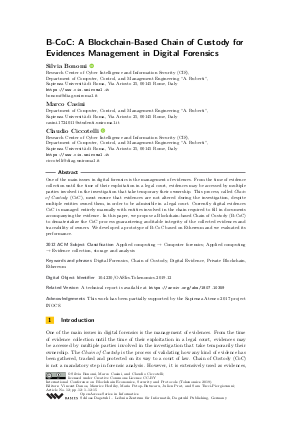@InProceedings{bonomi_et_al:OASIcs.Tokenomics.2019.12,
author = {Bonomi, Silvia and Casini, Marco and Ciccotelli, Claudio},
title = {{B-CoC: A Blockchain-Based Chain of Custody for Evidences Management in Digital Forensics}},
booktitle = {International Conference on Blockchain Economics, Security and Protocols (Tokenomics 2019)},
pages = {12:1--12:15},
series = {Open Access Series in Informatics (OASIcs)},
ISBN = {978-3-95977-108-5},
ISSN = {2190-6807},
year = {2020},
volume = {71},
editor = {Danos, Vincent and Herlihy, Maurice and Potop-Butucaru, Maria and Prat, Julien and Tucci-Piergiovanni, Sara},
publisher = {Schloss Dagstuhl -- Leibniz-Zentrum f{\"u}r Informatik},
address = {Dagstuhl, Germany},
URL = {https://drops-dev.dagstuhl.de/entities/document/10.4230/OASIcs.Tokenomics.2019.12},
URN = {urn:nbn:de:0030-drops-119767},
doi = {10.4230/OASIcs.Tokenomics.2019.12},
annote = {Keywords: Digital Forensics, Chain of Custody, Digital Evidence, Private Blockchain, Ethereum}
}

 Creative Commons Attribution 3.0 Unported license
Creative Commons Attribution 3.0 Unported license


